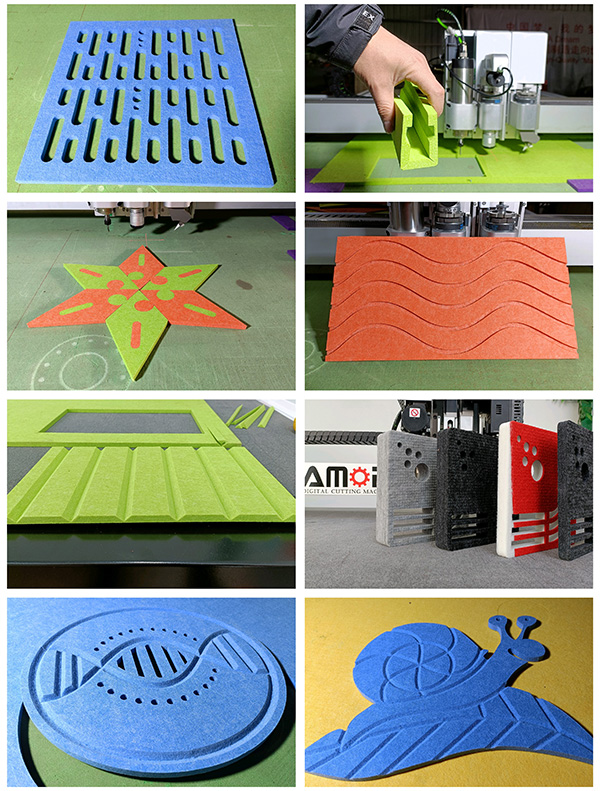What Is a Pneumatic Oscillating Tool?
The pneumatic oscillating tool operates using compressed air, which gives it the power to cut through tough and dense materials like thicker polyester fiber panels (24-50mm). It’s particularly useful when you need raw power to slice through layers quickly without struggling.
However, this power comes at the cost of speed and efficiency when cutting thinner materials. If you’re primarily working with 9-12mm panels, the pneumatic tool’s raw strength can be overkill and slows down production. In this case, the pneumatic tool is like a heavy-duty truck: powerful, but slower in comparison to its electric counterpart.

What Is an Electric Oscillating Tool?
The electric oscillating tool runs on electricity and is designed for more precise, controlled cuts. It excels in speed when working with thin polyester fiber panels in the 9-12mm range. With higher efficiency and greater precision, the electric tool performs like a sports car—it zips through thin materials with ease but doesn’t have the same brute strength for thicker cuts.
For manufacturers dealing with precision tasks or lighter materials, the electric tool is often the preferred choice, especially when speed is a critical factor in meeting production deadlines.

Which Tool Provides More Power?
When it comes to cutting thicker polyester fiber panels (24-50mm), the pneumatic oscillating tool is the clear winner. Its compressed air system delivers more power, allowing it to handle thicker and denser materials. If you’re working with panels that require deeper cuts or multiple layers, pneumatic tools give you the force needed to get through without issue.
The electric oscillating tool, while efficient for thinner panels, doesn’t have the same level of force. Its strength lies in precision and speed for less dense materials, making it more suited for thinner panels where control is more critical than brute power.

Which Tool Offers Better Precision?
Precision is where the electric oscillating tool takes the lead. Its controlled power and smoother operation allow for fine, detailed cuts, particularly on thinner panels (9-12mm). When you need to make intricate cuts or avoid overcutting, the electric tool offers the finesse and accuracy necessary for clean finishes.
The pneumatic tool, while excellent for heavy-duty cutting, can be harder to control for smaller, detailed work due to its higher power and speed. If your projects require both power and precision, it’s often best to combine both tools for optimal results.

Which Tool Is More Efficient for High-Volume Work?
When it comes to high-volume production, the choice of tool depends on the material thickness. For thicker materials, the pneumatic oscillating tool is more efficient. Its power allows it to handle larger, tougher jobs quickly, making it ideal for cutting through 24-50mm thick polyester fiber panels in a production environment.
However, for thinner materials (9-12mm), the electric oscillating tool offers more speed and efficiency. It can process panels faster, which is crucial when you’re trying to meet tight production schedules for large orders. Each tool has its place, but the right one for the job depends entirely on the material you’re cutting.

Which Tool Requires Less Maintenance?
When considering long-term use, electric oscillating tools have the edge in terms of lower maintenance. Since they don’t require an air compressor or complex pneumatic systems, they have fewer moving parts and, therefore, less to maintain. The electric tool is typically easier and cheaper to repair, making it a more cost-effective choice over time.
Pneumatic tools, while powerful, require more frequent maintenance, particularly of the air compressor system. If not maintained properly, these systems can cause downtime in production, which can be costly. However, if you’re working primarily with thicker materials, the additional maintenance might be worth the trade-off for the power and efficiency the pneumatic tool provides.

Tool Recommendation Based on Material Thickness
If your work mainly involves cutting 9-12mm thin polyester fiber panels, we recommend using the electric oscillating tool due to its speed and precision for this thickness range. However, for cutting 24-50mm thick polyester fiber panels, the pneumatic oscillating tool is a clear choice, as it’s better equipped to handle dense and thick materials.
But what if you need to cut both thin and thick panels? Fortunately, you don’t have to choose one tool over the other. By configuring your CNC machine with both pneumatic and electric oscillating tools, you can switch between them depending on the material thickness. This versatility ensures that you can tackle any job efficiently, whether you’re cutting thin or thick polyester fiber sound-absorbing panels.

Conclusion: Which Tool Is Best for Cutting Thick Polyester Fiber Panels?
In summary, both pneumatic and electric oscillating tools have their strengths and applications when cutting polyester fiber panels. For thicker, denser panels (24-50mm), the pneumatic tool offers the necessary power and efficiency. For thinner panels (9-12mm), the electric tool provides superior speed and precision.
If your projects require cutting materials of varying thickness, there’s no need to compromise. With the right setup, you can use both tools to maximize efficiency and quality in your production process.



